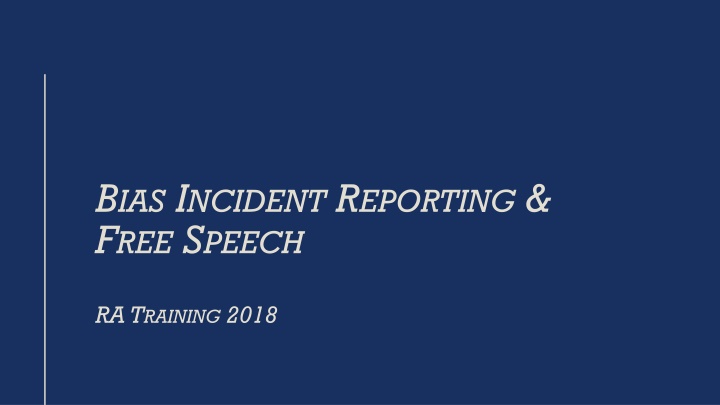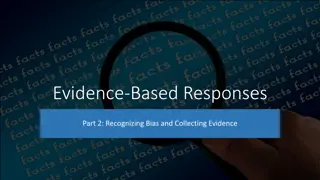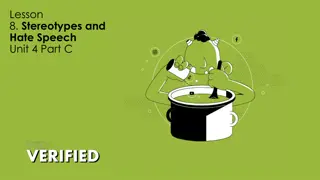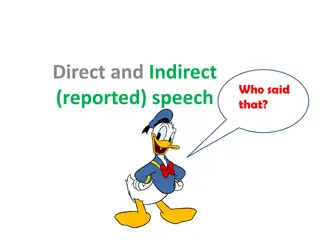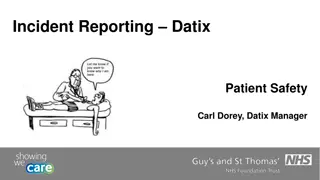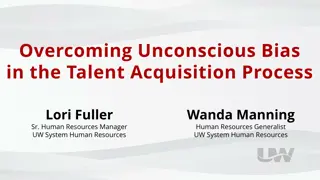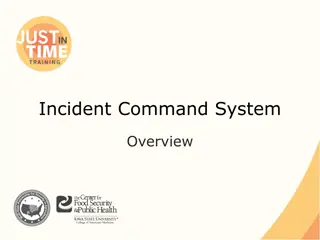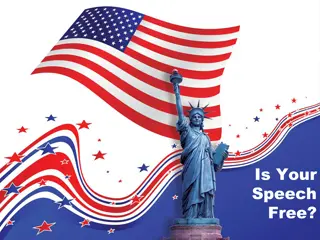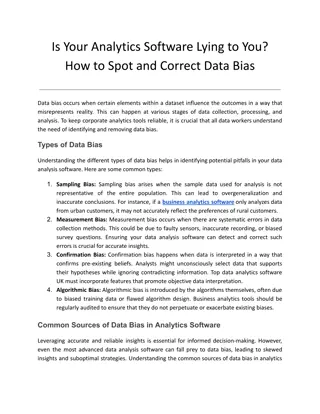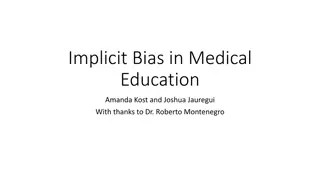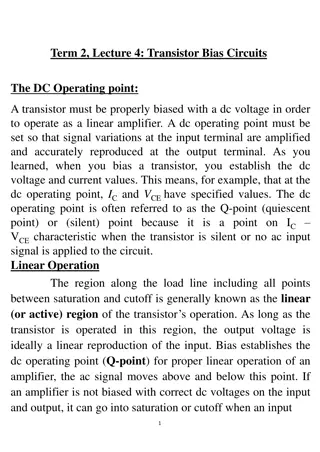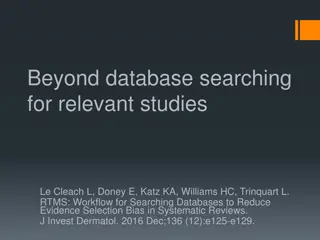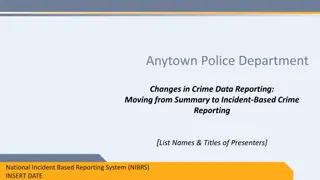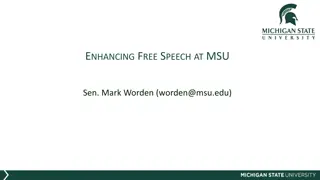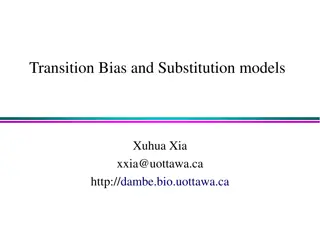Bias Incident Reporting & Free Speech Training Overview
Importance of addressing bias incidents, supporting free speech, and creating a positive campus climate. Learn about bias, implicit bias, microaggressions, and bystander intervention. Understand why addressing bias is crucial for fostering an inclusive environment.
Download Presentation

Please find below an Image/Link to download the presentation.
The content on the website is provided AS IS for your information and personal use only. It may not be sold, licensed, or shared on other websites without obtaining consent from the author.If you encounter any issues during the download, it is possible that the publisher has removed the file from their server.
You are allowed to download the files provided on this website for personal or commercial use, subject to the condition that they are used lawfully. All files are the property of their respective owners.
The content on the website is provided AS IS for your information and personal use only. It may not be sold, licensed, or shared on other websites without obtaining consent from the author.
E N D
Presentation Transcript
BIAS INCIDENT REPORTING & FREE SPEECH RA TRAINING 2018
DISCUSSION OVERVIEW What is bias? Why is addressing bias important? climate, retention, satisfaction Reporting bias incidents Necessary tension: Addressing bias and supporting free speech Bystander intervention
What kind of campus are we trying to create? Video
What is Bias? Prejudice in favor of or against one thing, person, or group compared with another, usually in a way considered to be unfair. What is Implicit Bias? The way people unconsciously and sometimes unwillingly exhibit bias toward other individuals and groups.
What is a bias incident? A bias incident is when anyone in the Grand Valley community feels belittled, disrespected, or isolated based on their identity.
Why do acts of bias occur? Hatred Arrogance Lapse of judgment Ignorance Stereotypes Privilege Power of peer group Social acceptance Unaware of our implicit bias
Bias often shows up as a microaggression MICROAGRESSIONS.com
How might bias impact our interactions? Depending on WHO the actor - how do you perceive people . Who is loud vs. playful ? Who is assertive vs. aggressive ? Who is expressive vs. angry ? Who is smart vs. challenged ?
WHY IS ADDRESSING BIAS IMPORTANT?
CULTURE creates CLIMATE
Campus Climate Study 2015 87% of the campus report feeling very comfortable or comfortable (national average is 78%) 75% of people of color reported feeling very comfortable or comfortable 59% of those identifying as transgender/other gender reported feeling very comfortable or comfortable Climate was slightly less comfortable in the unit/college (84%) for employees classroom (85%) for students and faculty living centers (77%) for students
14% of the campus personally experienced a negative or hostile incident in the past year at GV (national average is 23%) 26% of LGBQA 24% of people with disabilities 21% of people of color 10% of the campus has seriously considered leaving GV in the past year (national average is 18%) 25% Transgender/Other Gender considered leaving at higher rates 18% People of color 17% LGBQA 15% People with disabilities
How to report a Bias Incident Staff in the Dean of Students Office or Office of Inclusion and Equity will make contact. Bias Incident Report Form : gvsu.edu/bias What happened Where it happened You can upload pictures or documents with your report You can fill it out anonymously
The following report summarizes the bias incidents that have been reported during the Fall 2017: Tracking and Sharing There were 49 bias incidents reported to the Dean of Students Office. Forty-three occurred on the Allendale campus. Four incidents occurred on the Pew campus. Two were at off campus locations. Eighteen incidents occurred in living centers. Reports included 23 incidents regarding race, 10 incidents regarding religion,10 incidents regarding sexual orientation, 7 incidents regarding gender, 2 regarding national origin, 5 regarding gender identity, and 2 political affiliation. All reported incidents were reviewed and follow up with reporting and responding parties occurred when applicable. Support was provided to victim(s) and/or the reporting individuals (where this was known). Examples of follow-up include discussions with students, faculty, and staff and/or educational programming with departments.
Data 2015-16 81 Incidents 2016-17 120 Incidents 2017-18 85 Incidents
Context for Bias Incident Reporting We are committed to safeguarding individuals constitutional right to free speech and assembly. AND We are also committed to addressing incidents of bias which may affect individuals and/or communities.
1st Amendment Congress shall make no law respecting an establishment of religion, or prohibiting the free exercise thereof; or abridging the freedom of speech, or of the press; or the right of the people peaceably to assemble, and to petition the Government for redress of grievances. How does is it pertain to higher education?
GVSU is a public institution Bound to uphold the constitution of the United States The First Amendment to the U.S. Constitution guarantees Freedom of Speech Exceptions to 1st Amendment protections apply? True threats of violence Inciting or producing imminent lawless action Fighting words Discriminatory harassment Obscenity (sexual in nature) Libel and defamation Disruption to the educational environment
We can enact reasonable restrictions to speech ..as long as they are content neutral Time Place Manner
Grounds and Facilities Use Policy Basics . Can t block access to campus buildings and does not impede ingress or egress Can t interfere with academic learning (50 feet from academic bldgs.) Can t obstruct vehicular or pedestrian traffic. Can t engage in unlawful activity. Can t create a clear and present threat to public safety. Can t use any amplification devices.
Hate Speech Speech that attacks, threatens, or insults a person or group on the basis of national origin, ethnicity, color, religion, gender, gender identity, sexual orientation, or disability. Hate Crime Hate crimes are motivated by bias, but they include a definable crime, such as: threats of violence, property damage, personal injury and other illegal conduct. It is crime that was committed because of the actual or perceived religion, national origin, gender, sexual orientation, gender identity, or disability of any person, and the crime affected interstate or foreign commerce, or occurred on federal property. (See http://www.justice.gov/crt for more information on this law).
TEACHING HOW TO BE AN ACTIVE BYSTANDER
Active Bystander Suggestions from GVSU Students about what you can say in the presence of bias: Did I hear you right? You don t really believe that all people Can you explain why you said that? Not funny. No, thanks. That s rude and immature. I don t think that s a good idea!
Resources Questions Thank you!
